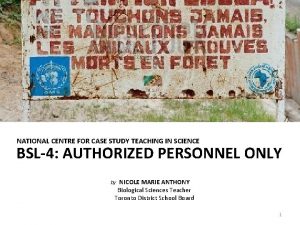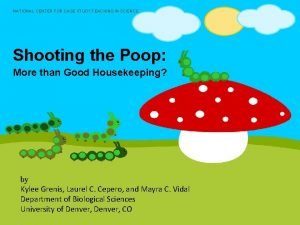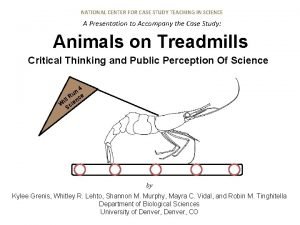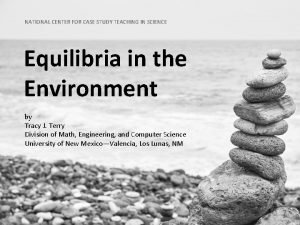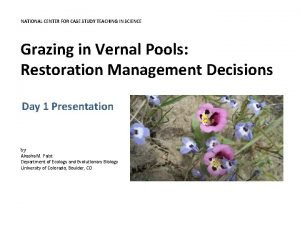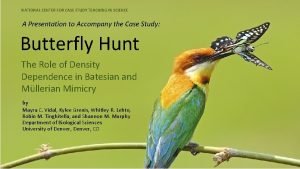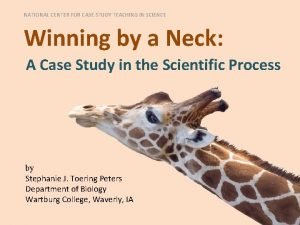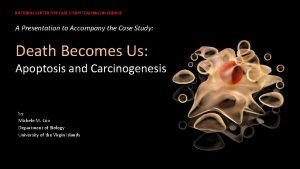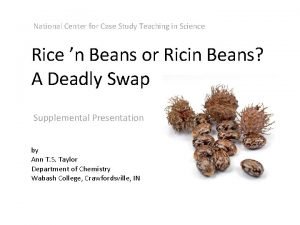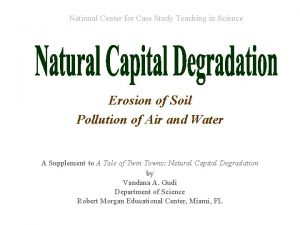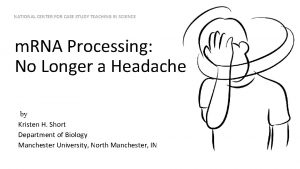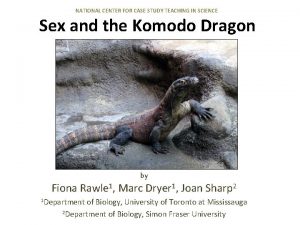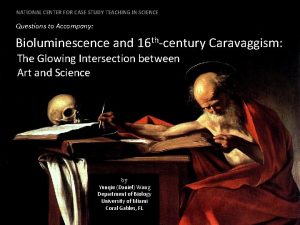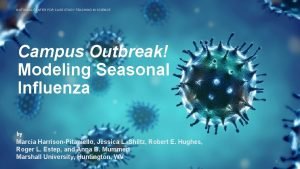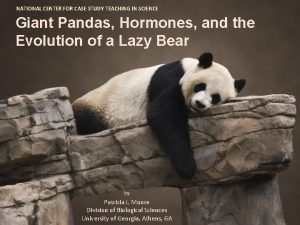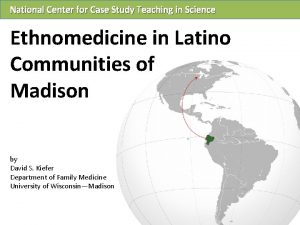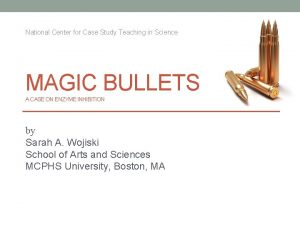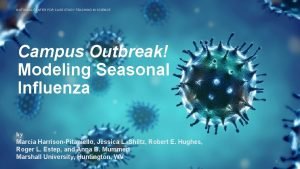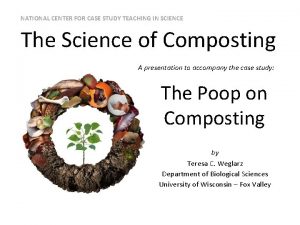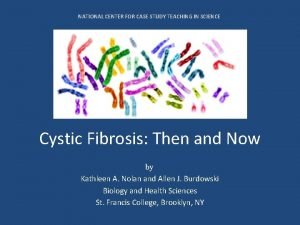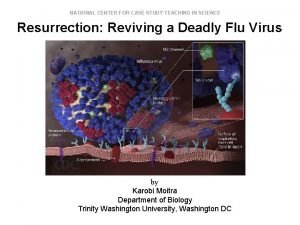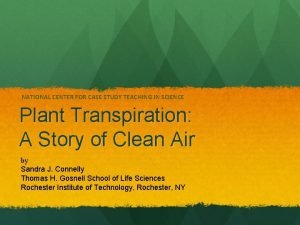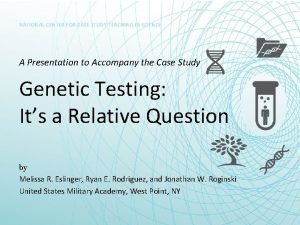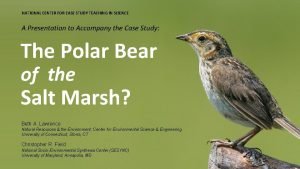NATIONAL CENTER FOR CASE STUDY TEACHING IN SCIENCE


































- Slides: 34

NATIONAL CENTER FOR CASE STUDY TEACHING IN SCIENCE The Horseshoe Crab: A True Blue-Blood by Kathleen A. Nolan Department of Biology, Health Promotion and Health Care Management St. Francis College, Brooklyn, NY 1

CQ#1: What causes the blood to be blue? a. The iron in hemoglobin b. The copper in hemoglobin c. The copper in myoglobin d. The iron in hemocyanin e. The copper in hemocyanin 2

Kin, A. , & Błażejowski, B. (2014). The Horseshoe Crab of the Genus Limulus : Living Fossil or Stabilomorph? Plos ONE, 9(10), 1 -11. 3

Can you tell the male and the female apart? How? 4

Male clasper appendages 5

Spawning in Delaware Bay 6

Horseshoe crabs spawning 7

8

9

10

Red knots feeding on horseshoe crab eggs. 11

12

Can you guess what these are? 13

Photo courtesy Mark Botton, Ph. D. Fordham College Embryos! 14

15

16

RG 1380. 006 Board of Agriculture Glass Negative Collection Creator Hammond, Roydon L. Delaware Public Archives Can you guess what these horseshoe crabs were used for? 17

RG 1380. 006 Board of Agriculture Glass Negative Collection Creator Hammond, Roydon L. Delaware Public Archives FERTILIZER!! 18

Watch this three-minute video on one of the key stakeholders: NATURE | Crash: A Tale of Two Species | Blue Blood | PBS 3 min. http: youtu. be/e 8 Kl. Amt. Iu 1 E 19

CQ#2: What is the net worth of a liter of horseshoe crab “blood” (hemolymph)? a. $10, 000 b. $100 c. $15, 000 d. $1000 e. 1 million dollars 20

CQ#3: How many horseshoe crabs are taken for “blood-letting” every year from the five LAL companies in the U. S. ? a. 10, 000 b. 1, 000 c. 1 million d. 500, 000 e. 300, 000 21

CQ#4: Limulus amebocyte lysate (LAL) works in the following way: a. Amoebocytes react with harmful viruses b. Amoebocytes react with endotoxins produced by bacteria c. Hemocyanin reacts with endotoxins produced by viruses d. Hemocyanin reacts with endotoxins produced by bacteria e. Amoebocytes react with endotoxins produced by fungi only 22

CQ#5: According to Leschen and Correia (2010), what was the approximate mortality of the horseshoe crabs in their study? a. 10% b. 15% c. 30% d. 40% e. 50% 23

CQ#6: An organism that is an osmotic conformer… a. Changes its osmolality at various salinities b. Is not able to change its osmolality at various salinities c. Can only adjust to one salinity d. Needs to conform to a certain hemocyanin saline concentration e. Needs to conform to a certain hemocyanin glucose concentration photograph by Lauren Clarke 24

What is meant by “landings”? Can you explain the peak? 25

What is a “quota distribution plan? ” (This one is for NY. ) Why is it variable? 26

Compare and contrast these data. Quotas set by ASMFC for HSC’s for 2018 27

Discuss trends that you see. http: //www. asmfc. org/species/horseshoe- crab 28

29

Stakeholder Table Stakeholder Conservation Development Educator Ecologist Paleontologist Medical researcher Bird watcher Environmentalist Hotel owner Eel fisherman Bait collector Government scientist 30

What are your conclusions? 31

Image Credits Slide 1 Gregory Breese/USFWS, public domain https: //www. flickr. com/photos/usfwsnortheast/4035509350/ Slide 3 Kin, A. , B. Błażejowski. 2014. Plos ONE 9(10): 1– 11. CC BY 4. 0 https: //doi. org/10. 1371/journal. pone. 0108036 Slide 4. Curious Expeditions, CC BY-NC-SA 2. 0 https: //www. flickr. com/photos/curiousexpeditions/870679908/ Slide 5 Maurice. JFox 3, CC BY 2. 5 https: //commons. wikimedia. org/wiki/File: Horseshoe_crab_male_pedipalp. jpg Slide 6 Gregory Breese/USFWS, public domain https: //www. flickr. com/photos/usfwsnortheast/4035246616/in/photostream/ Slide 7 Asturnut, CC BY-SA 3. 0 https: //en. wikipedia. org/wiki/File: Horseshoe_crab_mating. jpg Slide 8 Hayden, CC BY 2. 0 https: //commons. wikimedia. org/wiki/File: Horseshoe_Crabs_mating. jpg Slide 9 Michael Lusk, CC BY-NC 2. 0 https: //www. flickr. com/photos/killkudzu/3594378740 Slide 10 Gregory Breese/USFWS, public domain https: //www. flickr. com/photos/usfwsnortheast/4035580656/ 32

Slide 11 Gregory Breese/USFWS, public domain https: //www. flickr. com/photos/usfwsnortheast/4035465562/ Slide 12 Mark Botton, used with permission. Slide 13, 14 (Horseshoe crab embryos) Doug Wechsler, used with permission. https: //dougw. photoshelter. com/index Slide 14 (Photo of larva on right) Photo by Mark Botton. Used with permission. Slide 15 Derek Perry, used with permission Slide 16 CC BY-SA 2. 0 https: //www. flickr. com/photos/138014579@N 08/27256381030 Slides 17 and 18 Delaware Public Archives, used with permission. Slide 20 Chosovi. CC BY-SA 2. 5 https: //commons. wikimedia. org/wiki/File: Limulus_polyphemus. jpg Slide 21 Didier Descouens, CC BY-SA 4. 0 https: //commons. wikimedia. org/w/index. php? curid=8394621 Slide 22 Didier Descouens, CC BY-SA 4. 0 https: //commons. wikimedia. org/w/index. php? curid=8394621 Slide 23 domdomegg, CC BY 4. 0 https: //commons. wikimedia. org/wiki/File: Atlantic_horseshoe_crab_(Limulus_polyphemus)_(5). jpg 33

Slide 24 Photo by Lauren Clark, student of K. Nolan, used with permission. Slides 25, 27, 28 and 29 Atlantic States Marine Fisheries Commission, used with permission. Slide 26 New York State Department of Environmental Conservation, used with permission. http: //www. dec. ny. gov/outdoor/100858. html Slide 30 Table made by K. Nolan Slide 31 Didier Descouens, CC BY-SA 4. 0 https: //commons. wikimedia. org/w/index. php? curid=8394621 34
 National center for case study teaching in science
National center for case study teaching in science National center for case study teaching in science
National center for case study teaching in science National center for case study teaching in science
National center for case study teaching in science National center for case study teaching in science answers
National center for case study teaching in science answers National center for case study teaching in science
National center for case study teaching in science National center for case study teaching in science
National center for case study teaching in science National center for case study teaching in science
National center for case study teaching in science Best worst and average case
Best worst and average case Foxmeyer erp failure case study
Foxmeyer erp failure case study My favorite subject is p.e
My favorite subject is p.e Purposes of micro teaching
Purposes of micro teaching Kontinuitetshantering i praktiken
Kontinuitetshantering i praktiken Typiska novell drag
Typiska novell drag Nationell inriktning för artificiell intelligens
Nationell inriktning för artificiell intelligens Ekologiskt fotavtryck
Ekologiskt fotavtryck Varför kallas perioden 1918-1939 för mellankrigstiden?
Varför kallas perioden 1918-1939 för mellankrigstiden? En lathund för arbete med kontinuitetshantering
En lathund för arbete med kontinuitetshantering Personalliggare bygg undantag
Personalliggare bygg undantag Tidbok för yrkesförare
Tidbok för yrkesförare Sura för anatom
Sura för anatom Densitet vatten
Densitet vatten Datorkunskap för nybörjare
Datorkunskap för nybörjare Boverket ka
Boverket ka Debatt mall
Debatt mall För och nackdelar med firo
För och nackdelar med firo Nyckelkompetenser för livslångt lärande
Nyckelkompetenser för livslångt lärande Påbyggnader för flakfordon
Påbyggnader för flakfordon Tryck formel
Tryck formel Svenskt ramverk för digital samverkan
Svenskt ramverk för digital samverkan Lyckans minut erik lindorm analys
Lyckans minut erik lindorm analys Presentera för publik crossboss
Presentera för publik crossboss Vad är ett minoritetsspråk
Vad är ett minoritetsspråk Kanaans land
Kanaans land Treserva lathund
Treserva lathund Mjälthilus
Mjälthilus
